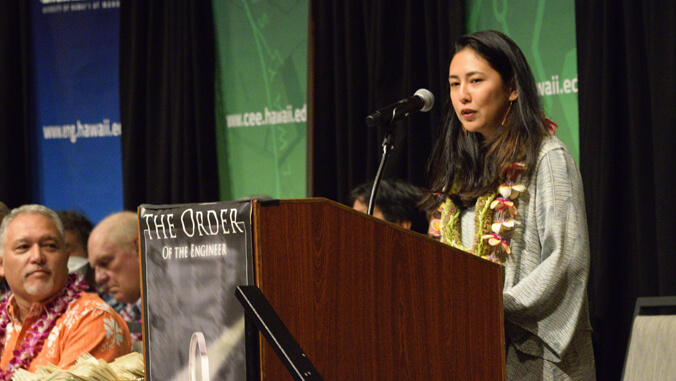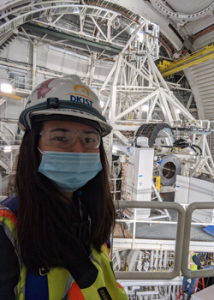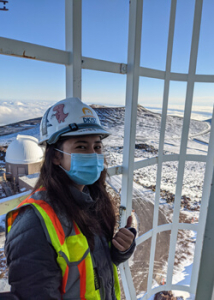
Brialyn Onodera, an engineer for the world’s largest solar telescope, developed her passion in the University of Hawaiʻi System and is giving back to the communities she grew up in.

The Hilo native earned her bachelor’s degree in mechanical engineering and executive master’s in business administration from UH Mānoa. For the past several years, she has worked as a mechanical engineer for the National Solar Observatory at the Daniel K. Inouye Solar Telescope (DKIST) atop Haleakalā.
In spring 2023, Onodera was invited to be the featured speaker at the UH Mānoa College of Engineering’s convocation ceremony at the Hawaiʻi Convention Center on May 12.
“My speech was centered around how, as engineering graduates, they’re going out into the world to do a variety of great things, but to also remember it’s important to give back to your community,” Onodera said. “As engineers, we solve problems for people, and in order to uplift our community we can channel our passions for problem solving into productive ways to make other people’s lives better.”
Onodera added, “That’s why it’s so important to me that I’ve always been in Hawaiʻi and I want to continue to contribute to the community that I was raised in, and part of that was possible because of my education at UH. That was my message to them, to care about how your work impacts others.”
Developing her passion at UH

Onodera grew up in Hilo, where she could catch a clear view of the summit of Maunakea on a nice day. Along with being close to the mauna and the telescopes there, Onodera remembers attending events related to Ellison Onizuka Day—in honor of the late U.S. astronaut from Hawaiʻi, who died aboard the Space Shuttle Challenger—at UH Hilo, which inspired her to pursue a career in engineering.
After graduating from Kamehameha Schools Hawaiʻi in Keaʻau, Onodera attended UH Hilo’s pre-engineering program before transferring to UH Mānoa’s College of Engineering.
“I think one of the best parts (about attending the College of Engineering) was getting to meet and work with so many great people, especially those who I have kept in touch with and are continuing to do interesting work. I like the fact that we’re all from Hawaiʻi,” Onodera said. “It was nice to build my network and career here. Having that community is what really made the whole process rewarding.”
Working at DKIST

Before graduating in 2017, Onodera worked at multiple internships, including at DKIST, through the Akamai Workforce Initiative, led by the Institute for Scientist and Engineer Educators at University of California Observatories, in partnership with UH’s Institute for Astronomy and UH Hilo. Soon after graduating, Onodera was offered a full-time position at DKIST as a mechanical engineer.
“That was cool for me because after I graduated I didn’t even apply with DKIST, they asked to interview me,” Onodera said. “It was nice that I made a distinct impression on them through my internship. And it really shows, being a part of the team now, that they really care about being engaged with the community and having a workforce that’s local.”
One aspect of Onodera’s work at DKIST focuses on vibrations within the telescope. As the telescope captures closeup images of the sun, any slight vibrations can impact the optical path or the instruments collecting data—imagine looking through a pair of binoculars and someone is shaking you. As a solar observatory DKIST has several vibration sources present in the form of a complex thermal system (featuring pumps, fans, motors, etc) that maintains the facility’s operating conditions. Onodera assists with collecting data on high impact vibration, analyzing it to determine the root cause and working on an engineered solution that mitigates those effects.
Building on educational foundations
Aside from her full-time work, Onodera also earned an executive master’s in business administration from the Shidler College of Business in 2022.
“I went back to get my MBA because I knew that as you progress in your career, you eventually have to manage people. Gaining leadership skills is essential, especially for someone like me who wants to be involved in the community,” Onodera said. “I wanted to learn the skill sets I needed to be able to communicate with people effectively and learn to better manage people and projects.”
Onodera is a Native Hawaiian community representative on the Mauna Kea Working Group, which develops recommendations for a new governance and management structure for Maunakea that collaboratively engages with all stakeholders, particularly the Native Hawaiian community. She also volunteers her time and supports efforts that improve the visibility and presence of kamaʻāina within STEM projects in Hawaiʻi, and serves as a role model for future STEM students wanting to give back to their communities.
“I think that is more important than ever because there are locals who are forced to leave the islands. It’s really hard when you see people that you grew up with having to leave,” Onodera said. “That’s why I think that it is important to support people who are invested in being in Hawaiʻi and creating opportunities for them to stay.”
—By Marc Arakaki

